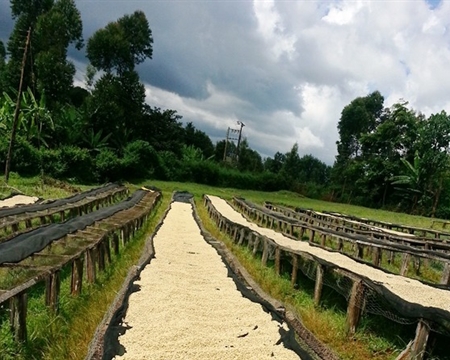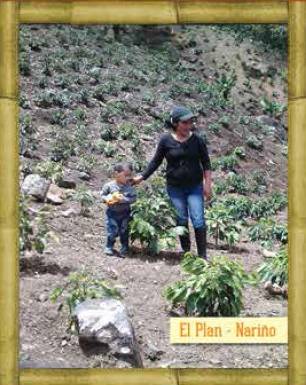Colombia Na Linglong Consa Kaplan Estate
About coffee cultivation in Colombia
Planting area and harvest season
Columbus coffee cultivation is distributed along the Andes Mountains, from south to north, roughly divided into northern producing areas (green), central producing areas (orange, purple) and southern producing areas (yellow), in which orange-purple areas have primary and secondary production seasons. green and yellow areas have one season.

Harvest season [by region]
Due to the differences in geographical and climatic characteristics from north to south, the north-south production season is just opposite, while the central part has its own primary and secondary production seasons according to whether it is south or north. It can be said that beans are produced all the year round. We mainly distinguish regions according to winter production season and summer production season.
The winter season is from September to December, including the following areas
Magdalena Magdalena common items
Santander Santander
Antioquia Andi O'Quia common items
North of Santander North of Santander
Boyaca Boyaca
Meta Matta
The central region near the north will have two primary and secondary seasons, the main season is from September to December in winter, and the secondary season is between April and May in summer.
Caldas Caldas
Risaralada Salala da
Parts of Cundinamarca Quintina Maka have begun to emerge in the market.
Some areas of Quinido Jindio began to emerge in the market.
Common items of sub-ashes in some areas of Tolima Tolima
The central region near the south will have two primary and secondary seasons, the main season is from March to June in summer, and the secondary season is from October to November in winter.
Parts of Valle Waye began to emerge in the market.
Parts of Quindio Kingdeo
Cundinamarca Quintina Maka part of the area
Part of Tolima Tolima
The summer production season is from March to June, including the following areas
Part of Valle Waye
The bone ash grade of Cauca test is common.
Cundinamarca Quintina Maka part of the area
Huila Huila ashes grade is common.
Narino Na Linglong secondary bone ash grade is common
Note: the production season here refers to the stage of post-processing when the coffee fruit is ripe and harvested in the producing area. Usually 2-3 months after this stage, the beans of the real new production season will arrive at our consumption end.
Planting pattern: 95% of the growers are small farmers, and the family planting area is less than 5 hectares.
Production: the average annual output of small farmers' families is 25 bags, each bag 70kg specification
Planting altitude: 1000-2500 m
Annual precipitation: 1000-2500 mm
Average annual temperature: 15.8-20.5 degrees Celsius
Planting varieties: in addition to Kaddura Caturra, Bourbon Bourbon, Tippika Typica and Parkmara, which are common in America, Colombia also has three disease-resistant varieties peculiar to Colombia, namely Castillo Castillo and Tabi Tabi Colombian Colombia with the same name as the country. Of course, there are also some rare and valuable varieties such as Rosa Gesha, small-grained Mocha Mocca, Rume Sudan Romer Sultan, Eugenioides Eugene Odes, Laurina pointed Bourbon, Maraguesa Mara Rosa (a natural hybrid between Malaggippe and Rosa).
Shade trees: the shade trees seen in the producing areas are lemon trees and orange trees. the lemons in their lemon trees are very similar to oranges, but they taste very sour, and there is a local way to eat them with a strong liquor, just like drinking cocktails. It tastes good.
Production season: affected by the topography of the Andes, Colombia is divided into three regions from south to north, northern, central, and southern; the northern part of the south has a distinct production season, and the central part has two primary and secondary seasons according to the north or the south, respectively. there's information behind it.
Treatment methods: water washing is the main way, and now there are sun and honey treatment methods; in water washing methods, most of the conventional fermentation processes are anhydrous fermentation Dry Fermentation, open environment; now there are some processes that introduce red wine treatment into coffee treatment to do anaerobic and oxygen-controlled fermentation treatment.
Drying: after drying, there are greenhouse Green House (not as big as the vegetable growing greenhouse in our countryside, think about the size of the balcony sunshine room), drying field Patio (an open space on the cement floor, recently seen wooden floor), dryer (many small farmers have this at home)
Columbia Yana exquisite Consacapoland Manor

Country of origin: Colombia
Producing area: Naling Longkangsaka Consaca, Narino
Manor / processing plant: El Plan
Grower: Maria Ernestina
Variety: Castillo Castillo
Altitude: 1689 m masl
Planting area: 3 ha has
Treatment: washing Ecomill Washed, Natural Fermentation, Sun Dried
(most of the pectin is removed by the degumming machine, then the residual pectin is decomposed by natural static fermentation, then washed with clean water, and then dried naturally)
Harvest year: June 2016
Auction lot number: HQT
Submission volume of competitive bid: 288kgs
Award: best Special Flavor nomination Best Extoicness Nomination
Density: 921 g Compact l
Moisture content: 11.5%
Baking degree: mild to moderate light to medium (Color Track 59-60)
Flavor characteristics: as refreshing as orange juice, sweet sucrose, smooth taste
Orange juice-like acidity, cane sugar sweet, smooth
Important Notice :
前街咖啡 FrontStreet Coffee has moved to new addredd:
FrontStreet Coffee Address: 315,Donghua East Road,GuangZhou
Tel:020 38364473
- Prev
About Kenya AA TOP Kirinaga
Kenya AA TOP Kirinyaga Baragwi Gachami GP Origin Profile 1. Kirinyaga is a mountain Kirinyaga, written in Chinese Kirinyaga. Easily found on maps, this is the name of the highest peak of Mount Kenya, Kenya's highest and Africa's second highest, and the local name of Mount Kenya. The reason why Europeans call Mount Kenya
- Next

[UTZ certification] "UTZ Kapeh" means "good coffee" in Mayan dialect.
For the exchange of professional baristas, please follow the coffee workshop (Wechat official account cafe_style) UTZ Kapeh means good coffee in Mayan dialect. The global UTZ certification of high-quality coffee means that the beans used are produced in a socially and environmentally responsible manner. UTZ certification was established in 1997, covering every raw coffee from growing to roasting.
Related
- Does Rose Summer choose Blue, Green or Red? Detailed explanation of Rose Summer Coffee plots and Classification in Panamanian Jade Manor
- What is the difference between the origin, producing area, processing plant, cooperative and manor of coffee beans?
- How fine does the espresso powder fit? how to grind the espresso?
- Sca coffee roasting degree color card coffee roasting degree 8 roasting color values what do you mean?
- The practice of lattes: how to make lattes at home
- Introduction to Indonesian Fine Coffee beans-- Java Coffee producing area of Indonesian Arabica Coffee
- How much will the flavor of light and medium roasted rose summer be expressed? What baking level is rose summer suitable for?
- Introduction to the characteristics of washing, sun-drying or wet-planing coffee commonly used in Mantenin, Indonesia
- Price characteristics of Arabica Coffee Bean Starbucks introduction to Manning Coffee Bean Taste producing area Variety Manor
- What is the authentic Yega flavor? What are the flavor characteristics of the really excellent Yejasuffi coffee beans?

